Think you might be unexpectedly pregnant? You probably have a lot of emotions and thoughts going through your mind.
But you are not alone. Take a moment to take a deep breath and know that there is hope and support available to you.
If you’re considering abortion, you deserve to have all the facts and to get your questions answered before you make your next steps. Keep reading to find out the risks and side effects you should be aware of before an abortion.
What Is the Abortion Pill?
The abortion pill method is also known as medication abortion, and it is a two-step process with two doses of medication taken several hours apart. The first dose is a medication called mifepristone (otherwise known by the name brand Mifeprex). This medication stops the pregnancy from continuing by blocking growth and implantation in the uterus.
The second dose, misoprostol, taken a few hours later, causes the uterus to contract, expelling the pregnancy and uterine tissue through the vagina.
Although it is more easily accessible than other abortion methods, the abortion pill is still a serious medical procedure. It is highly recommended to seek a doctor’s care, particularly for follow-up care to ensure the abortion is complete and no further complications are present.
The FDA approves the use of the abortion pill for terminations of early pregnancies up to 10 weeks. Pursuing medication abortion past this point in pregnancy could result in complications, such as incomplete abortion and the need for surgical intervention.
What Are the Risks of the Abortion Pill?
According to the Mayo Clinic, the following are potential physical risks of the abortion pill:
- Incomplete abortion
- Heavy and prolonged bleeding
- Infection
- Fever
- Digestive system discomfort
- An ongoing pregnancy if the procedure doesn’t work
What Is Surgical Abortion?
Abortions past 10 weeks in pregnancy require a method known as surgical abortion—an in-clinic procedure. In the state of Virginia, surgical abortion is legal up until the point of viability, generally determined to be around 24 weeks.
A common surgical abortion procedure known as dilation & curettage (D&C) involves a physician or abortion provider using medication to open or dilate the cervix and then removing the pregnancy using a medical instrument known as a curette which lightly suctions or scrapes tissue out of the uterus.
Because this method of abortion is typically done in-clinic and involves some type of sedation, the monetary cost of this procedure is typically much higher than medication abortion.
What Are the Risks of Surgical Abortion?
The Mayo Clinic quotes the following as potential physical risks of surgical abortion:
- Perforation (tearing or puncture) of the uterus
- Damage to the cervix
- Scar tissue on the uterine wall
- Infection
- Excessive bleeding
- Dizziness or fever
- Severe cramping
It is also important to note that either method of abortion may affect more than just your physical health. Consider that many women experience lasting emotional or psychological effects following an abortion.
How Do I Know My Next Steps?
As you navigate your pregnancy decision, the best first step you can take is to confirm your pregnancy. Your home test may have come back positive, but there’s still a lot to find out to know what your options are.
An ultrasound can answer many of your questions. And, in seeing a medical professional for in-person care, you can rest assured that your next steps are tailored to your unique needs.
At the Pregnancy Support Center of Southside Virginia, all of our services are free—there is no monetary cost to you, and we are here to help you navigate your pregnancy decision. schedule your appointment today.


